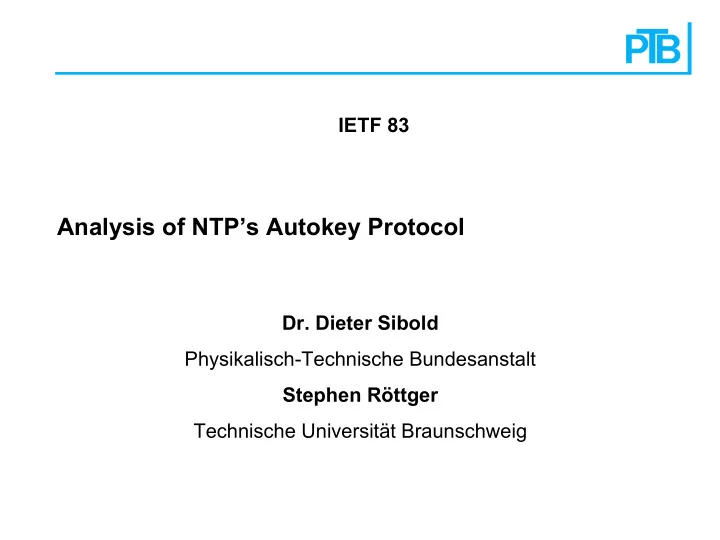

IETF 83 Analysis of NTP’s Autokey Protocol Dr. Dieter Sibold Physikalisch-Technische Bundesanstalt Stephen Röttger Technische Universität Braunschweig
Motivation PTB is Germany’s National Metrology Institute (NMI) Responsible for time dissemination (NTP and DCF77) Authenticity is an increasing challenge for time dissemination via NTP l Demand for securely authenticated time sources for home based smart meters; measuring of energy consumption and tariffing as a bases for billing l Increasing number of requests for an authenticated (public) NTP time service D. Sibold 2
Issues with existing approaches Pre-shared key l Organizational effort l No approval from official side (issues with compliance requirements) Autokey l Several vulnerabilities – in the Message Authentication Code (MAC) calculation and – the utilization of identity schemes l Compatibility issues D. Sibold 3
Weak spots / MAC / Client-Server Mode 1. Server seed is only 32 bits long → Client can request a cookie MAC and brute force the seed 2. The cookie is only 32 bits long; it is the only secret in the NTP generation of the autokey (in Packet autokey Client-Server Mode) → An adversary can capture a Client packet and brute force the & cookie Server cookie keyID 3. Client Identity Check: authenticity IP verification of the client is based on the client’s IP address Client → An adversary can & Server masquerade as the client server seed IP and obtain the client’s cookie encrypted with his own public key. D. Sibold 4
Weak spots / Identity Schemes • Trusted certification scheme provides no security enhancements • Private certificate scheme works but requires pre-shared keys • The three challenge response schemes (IFF, GQ, MV) are vulnerable against “man-in-the-middle” attacks • The challenge response schemes are not applied adequately, which makes them non-effective → an adversary can send a response to a client challenge, which will be accepted by the client D. Sibold 5
Suggested autokey improvements 1. Augmentation of the bit length of the server seed and the cookie to 128 bits, respectively 2. Client authenticity check based on client’s public key; cookie generation is then given by Cookie=Hash(public key of client || server seed) 3. Replacement of the identity schemes by a X.509 PKI 4. Optionally: signatures in extension fields cover the whole NTP packet 5. Optionally (for compliance reasons): utilization of NIST (or BSI) certified hash algorithms; e.g. key hashed MAC (HMAC) D. Sibold 6
Acknowledgement Stephen Röttger Technische Universität Braunschweig Institute of Theoretical Information Technology D. Sibold 7
Generation of cookie, autokey and MAC D. Sibold 8
Exploit of the lacking identity check D. Sibold 9
Recommend
More recommend